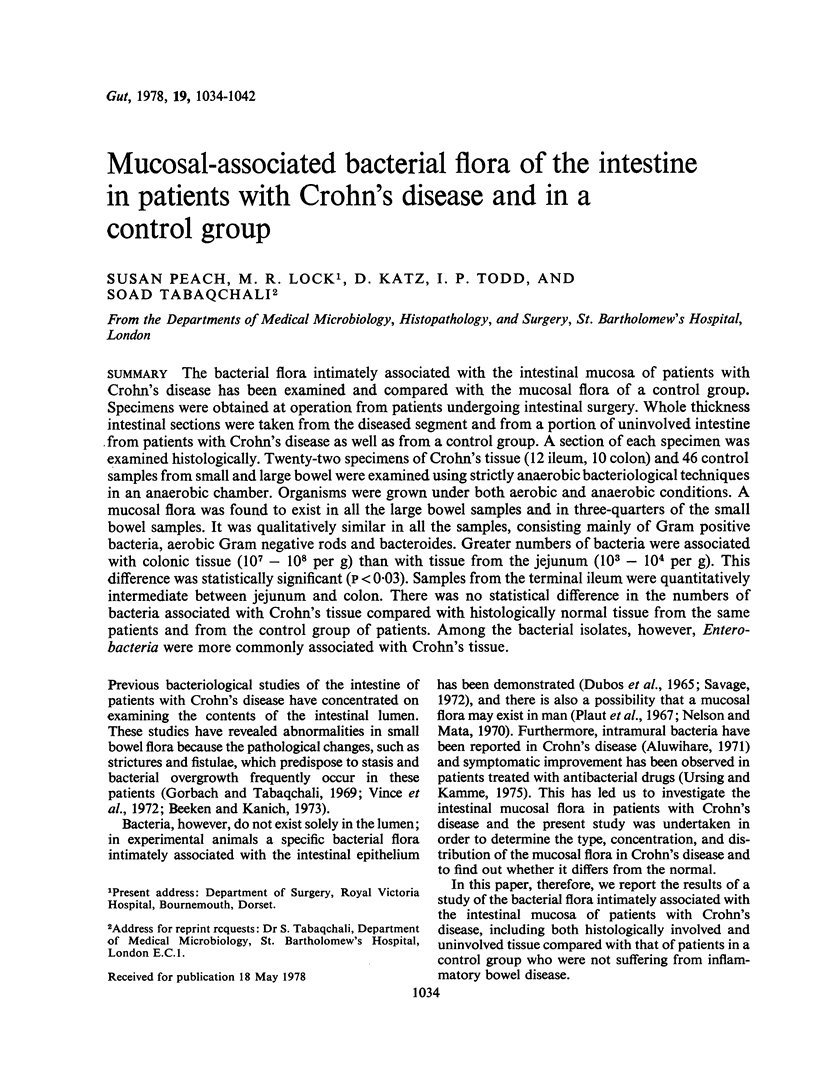Abstract
The bacterial flora intimately associated with the intestinal mucosa of patients with Crohn's disease has been examined and compared with the mucosal flora of a control group. Specimens were obtained at operation from patients undergoing intestinal surgery. Whole thickness intestinal sections were taken from the diseased segment and from a portion of uninvolved intestine from patients with Crohn's disease as well as from a control group. A section of each specimen was examined histologically. Twenty-two specimens of Crohn's tissue (12 ileum, 10 colon) and 46 control samples from small and large bowel were examined using strictly anaerobic bacteriological techniques in an anaerobic chamber. Organisms were grown under both aerobic and anaerobic conditions. A mucosal flora was found to exist in all the large bowel samples and in three-quarters of the small bowel samples. It was qualitatively similar in all the samples, consisting mainly of Gram positive bacteria, aerobic Gram negative rods and bacteroides. Greater numbers of bacteria were associated with colonic tissue (107 - 108 per g) than with tissue from the jejunum (103 - 104 per g). This difference was statistically significant (p<0·03). Samples from the terminal ileum were quantitatively intermediate between jejunum and colon. There was no statistical difference in the numbers of bacteria associated with Crohn's tissue compared with histologically normal tissue from the same patients and from the control group of patients. Among the bacterial isolates, however, Enterobacteria were more commonly associated with Crohn's tissue.
Full text
PDF








Selected References
These references are in PubMed. This may not be the complete list of references from this article.
- Aluwihare A. P. Electron microscopy in Crohn's disease. Gut. 1971 Jul;12(7):509–518. doi: 10.1136/gut.12.7.509. [DOI] [PMC free article] [PubMed] [Google Scholar]
- Arank A., Syed S. A., Kenney E. B., Freter R. Isolation of anaerobic bacteria from human gingiva and mouse cecum by means of a simplified glove box procedure. Appl Microbiol. 1969 Apr;17(4):568–576. doi: 10.1128/am.17.4.568-576.1969. [DOI] [PMC free article] [PubMed] [Google Scholar]
- Beeken W. L., Kanich R. E. Microbial flora of the upper small bowel in Crohn's disease. Gastroenterology. 1973 Sep;65(3):390–397. [PubMed] [Google Scholar]
- DUBOS R., SCHAEDLER R. W., COSTELLO R., HOET P. INDIGENOUS, NORMAL, AND AUTOCHTHONOUS FLORA OF THE GASTROINTESTINAL TRACT. J Exp Med. 1965 Jul 1;122:67–76. doi: 10.1084/jem.122.1.67. [DOI] [PMC free article] [PubMed] [Google Scholar]
- Gorbach S. L., Tabaqchali S. Bacteria, bile, and the small bowel. Gut. 1969 Dec;10(12):963–972. doi: 10.1136/gut.10.12.963. [DOI] [PMC free article] [PubMed] [Google Scholar]
- Hedges A. J., Howe K., Linton A. H. Statistical considerations in the sampling of Escherichia coli from intestinal sources for serotyping. J Appl Bacteriol. 1977 Oct;43(2):271–280. doi: 10.1111/j.1365-2672.1977.tb00751.x. [DOI] [PubMed] [Google Scholar]
- Moore W. E., Holdeman L. V. Human fecal flora: the normal flora of 20 Japanese-Hawaiians. Appl Microbiol. 1974 May;27(5):961–979. doi: 10.1128/am.27.5.961-979.1974. [DOI] [PMC free article] [PubMed] [Google Scholar]
- Nelson D. P., Mata L. J. Bacterial flora associated with the human gastrointestinal mucosa. Gastroenterology. 1970 Jan;58(1):56–61. [PubMed] [Google Scholar]
- PRESTON N. W., MORRELL A. Reproducible results with the Gram stain. J Pathol Bacteriol. 1962 Jul;84:241–243. doi: 10.1002/path.1700840131. [DOI] [PubMed] [Google Scholar]
- Peach S., Fernandez F., Johnson K., Drasar B. S. The non-sporing anaerobic bacteria in human faeces. J Med Microbiol. 1974 May;7(2):213–221. doi: 10.1099/00222615-7-2-213. [DOI] [PubMed] [Google Scholar]
- Perlmann P., Hammarström S., Lagercrantz R., Gustafsson B. E. Antigen from colon of germfree rats and antibodies in human ulcerative colitis. Ann N Y Acad Sci. 1965 Jun 30;124(1):377–394. doi: 10.1111/j.1749-6632.1965.tb18972.x. [DOI] [PubMed] [Google Scholar]
- Plaut A. G., Gorbach S. L., Nahas L., Weinstein L., Spanknebel G., Levitan R. Studies of intestinal microflora. 3. The microbial flora of human small intestinal mucosa and fluids. Gastroenterology. 1967 Dec;53(6):868–873. [PubMed] [Google Scholar]
- SCHAEDLER R. W., DUBS R., COSTELLO R. ASSOCIATION OF GERMFREE MICE WITH BACTERIA ISOLATED FROM NORMAL MICE. J Exp Med. 1965 Jul 1;122:77–82. doi: 10.1084/jem.122.1.77. [DOI] [PMC free article] [PubMed] [Google Scholar]
- Savage D. C. Associations of indigenous microorganisms with gastrointestinal mucosal epithelia. Am J Clin Nutr. 1970 Nov;23(11):1495–1501. doi: 10.1093/ajcn/23.11.1495. [DOI] [PubMed] [Google Scholar]
- Savage D. C. Localization of certain indigenous microorganisms on the ileal villi of rats. J Bacteriol. 1969 Mar;97(3):1505–1506. doi: 10.1128/jb.97.3.1505-1506.1969. [DOI] [PMC free article] [PubMed] [Google Scholar]
- Shorter T. G., Huizenga K. A., Spencer R. J., Aas J., Guy S. K. Inflammatory bowel disease. Cytophilic antibody and the cytotoxicity of lymphocytes for colonic cells in vitro. Am J Dig Dis. 1971 Aug;16(8):673–680. doi: 10.1007/BF02239587. [DOI] [PubMed] [Google Scholar]
- Tabaqchali S., O'Donoghue D. P., Bettelheim K. A. Escherichia coli antibodies in patients with inflammatory bowel disease. Gut. 1978 Feb;19(2):108–113. doi: 10.1136/gut.19.2.108. [DOI] [PMC free article] [PubMed] [Google Scholar]
- Thayer W. R., Jr, Brown M., Sangree M. H., Katz J., Hersh T. Escherichia Coli O:14 and colon hemagglutinating antibodies in inflammatory bowel disease. Gastroenterology. 1969 Sep;57(3):311–318. [PubMed] [Google Scholar]
- Ursing B., Kamme C. Metronidazole for Crohn's disease. Lancet. 1975 Apr 5;1(7910):775–777. doi: 10.1016/s0140-6736(75)92438-1. [DOI] [PubMed] [Google Scholar]
- Vince A., Dyer N. H., O'Grady F. W., Dawson A. M. Bacteriological studies in Crohn's disease. J Med Microbiol. 1972 May;5(2):219–229. doi: 10.1099/00222615-5-2-219. [DOI] [PubMed] [Google Scholar]
- WILLIS A. T., HOBBS G. A medium for the identification of clostridia producing opalescence in egg-yolk emulsions. J Pathol Bacteriol. 1958 Apr;75(2):299–305. doi: 10.1002/path.1700750208. [DOI] [PubMed] [Google Scholar]
- Whorwell P. J., Phillips C. A., Beeken W. L., Little P. K., Roessner K. D. Isolation of reovirus-like agents from patients with Crohn's disease. Lancet. 1977 Jun 4;1(8023):1169–1171. doi: 10.1016/s0140-6736(77)92714-3. [DOI] [PubMed] [Google Scholar]


